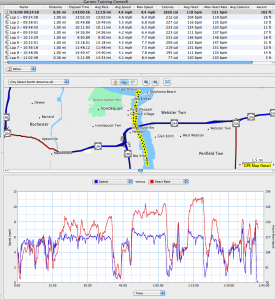
Unlike last May, when I hadn’t considered myself fit enough to do 2 miles of warm up, this time I did. And then we started off, doing 1.5 miles upstream. I had little trouble keeping up with the team for that 1.5 miles, but I had a hell of a time keeping my boat pointing in a straight line. I was constantly coming in too close to the other boats and banging into them, and then swerving out so far that I wasn’t getting much benefit from their wakes. But I was with them, and that was the important thing. The turn was at a point where the canal narrows down, and I got kind of scraped off when the sides narrowed in and Dan widened out. My boat just does not want to turn, and I had to slow down to a crawl and sweep like hell out the outside. By the time I got around the corner, I was about 200 feet or more behind, and I sprinted like hell to catch up, hitting speeds upwards of 7.7 mph. I caught up, but I couldn’t really find a sweet spot on anybody’s wake and didn’t really get a good recovery. Within a quarter of a mile I was losing them again. I tried to keep near their speed, but in the words of Jim M I just didn’t have any more poker chips. While I was about a hundred feet behind them, I saw Bill F suddenly stop and clean something off his paddle. As I was wondering what he was doing, I got a long piece of fishing line around my paddle and had to do exactly what I’d seen him do to clear it off. Jim M came up from behind where he’d been paddling with some of the slower paddlers and offered to drag me up to the lead pack again, but I just didn’t have any gas left and couldn’t raise my speed even a little. But on the plus side, my “dragging myself home in pain” speed was around 6.1-6.3 mph, whereas early this year 6.1-6.3 mph was my good speed. My time for the 5 miles was 46:29. In May, my time for 5 miles was 50:14. So I’m only 3 and 3/4 minutes faster over 5 miles than I was in spring, which doesn’t seem like much considering all the training and the new boat and everything. But I was only 1 and a half minutes behind the best of the team, so I should be pleased. Plus I’d done a 5 mile paddle yesterday, and I’m in a boat I’ve got almost no time in.
As we were warming down, the Colonial Belle came by and Mike and I went to ride its wake. I got a bit of a good ride for a minute or two, but I was too wiped to keep it up much, so I left Mike to play and went back to Dan’s dock. When I pulled my boat out of the water, I got a bit of a shock. I had about 30 feet of fishing line caught in my rudder. And at the end of that fishing line, a steel wire leader and a large fishing lure of a type I believe is known as a “popper” or “surface lure”. I guess I didn’t do as good a job as Bill of getting that fishing line out of our paddles. Paul D asked me if I had a fishing license. I wonder how much drag that stupid thing added to my boat.
But good paddle or bad, what really makes it all worth while was the chance to hang out with the team. It is a great group of guys, and I’m happy to have the chance to be a member of this great team.




